The Risk of Water Quality Deterioration with Urban Flood Control—A Case in Wuxi
Abstract
:1. Introduction
2. Materials and Methods
2.1. Study Area
2.2. Sample Collection and Laboratory Analysis
2.2.1. Parameter Selection
2.2.2. Water Sampling Time
2.2.3. Water Sample Processing
2.2.4. The Detection of Water Quality Indicators
2.3. Statistical Methods
2.3.1. Difference Analysis
2.3.2. Cluster Analysis (CA)
2.3.3. Water Quality Index
2.3.4. Mann–Kendall Trend
2.3.5. Time Series Analysis
3. Results and Discussion
3.1. Risk Periods Identification
3.2. Level and Degree of Contamination
3.3. Fluctuation and Trend of Pollutants
4. Conclusions
Supplementary Materials
Author Contributions
Funding
Institutional Review Board Statement
Informed Consent Statement
Data Availability Statement
Conflicts of Interest
References
- Haeffner, M.; Jackson-Smith, D.; Buchert, M.; Risley, J. Accessing blue spaces: Social and geographic factors structuring familiarity with, use of, and appreciation of urban waterways. Landsc. Urban Plann. 2017, 167, 136–146. [Google Scholar] [CrossRef]
- Kuo, P.-H.; Shih, S.-S.; Otte, M.L. Restoration recommendations for mitigating habitat fragmentation of a river corridor. J. Environ. Manag. 2021, 296, 113197. [Google Scholar] [CrossRef] [PubMed]
- Liu, M.; Zhao, L.; Li, Q.; Zou, J.; Hu, Y.; Zhang, Y.; Xu, P.; Wu, Z.; Deng, W.; Tao, J. Hydrochemical characteristics, main ion sources of main rivers in the source region of Yangtze River. China Environ. Sci. 2021, 41, 1243–1254. [Google Scholar] [CrossRef]
- Zhang, Z.; Zhang, H.; Feng, J.; Wang, Y.; Liu, K. Evaluation of social values for ecosystem services in urban riverfront space based on the solves model: A case study of the fenghe river, Xi’an, China. Int. J. Environ. Res. Public Health 2021, 18, 2765. [Google Scholar] [CrossRef] [PubMed]
- Chen, Y.; Xu, Y.; Zhou, K. The spatial stress of urban land expansion on the water environment of the Yangtze River Delta in China. Sci. Rep. 2022, 12, 17011. [Google Scholar] [CrossRef] [PubMed]
- Yang, H.; Li, Y.; Pu, Y.; Yao, X.; Yao, J. Spatio-temporal distribution characteristics and the river water quality of Zhangjiagang City. Acta Sci. Circumstantiae 2021, 41, 4064–4073. [Google Scholar] [CrossRef]
- Liu, J.; Shen, Z.; Yan, T.; Yang, Y. Source identification and impact of landscape pattern on riverine nitrogen pollution in a typical urbanized watershed, Beijing, China. Sci. Total Environ. 2018, 628, 1296–1307. [Google Scholar] [CrossRef]
- Huang, J.; Zhang, Y.; Bing, H.; Peng, J.; Dong, F.; Gao, J.; Arhonditsis, G.B. Characterizing the river water quality in China: Recent progress and on-going challenges. Water Res. 2021, 201, 117309. [Google Scholar] [CrossRef]
- Luo, Z.; Shao, Q.; Zuo, Q.; Cui, Y. Impact of land use and urbanization on river water quality and ecology in a dam dominated basin. J. Hydrol. 2020, 584, 124655. [Google Scholar] [CrossRef]
- Ho, M.; Lall, U.; Allaire, M.; Devineni, N.; Kwon, H.H.; Pal, I.; Raff, D.; Wegner, D. The future role of dams in the United States of America. Water Resour. Res. 2017, 53, 982–998. [Google Scholar] [CrossRef]
- Maavara, T.; Chen, Q.; Meter, K.V.; Brown, L.E.; Zhang, J.; Ni, J.; Zarfl, C. River dam impacts on biogeochemical cycling. Nat. Rev. Earth Environ. 2020, 1, 103–116. [Google Scholar] [CrossRef]
- Feng, L.; Hu, P.; Chen, M.; Li, B. Quantifying cumulative changes in water quality caused by small floodgates in Taihu Lake Basin—A case in Wuxi. Sci. Total Environ. 2023, 900, 165608. [Google Scholar] [CrossRef] [PubMed]
- Huang, C.; Li, X.-F.; You, Z. The Impacts of Urban Manufacturing Agglomeration on the Quality of Water Ecological Environment Downstream of the Three Gorges Dam. Front. Ecol. Evol. 2021, 8, 612883. [Google Scholar] [CrossRef]
- Kuriqi, A.; Pinheiro, A.N.; Sordo-Ward, A.; Bejarano, M.D.; Garrote, L. Ecological impacts of run-of-river hydropower plants—Current status and future prospects on the brink of energy transition. Renew. Sustain. Energy Rev. 2021, 142, 110833. [Google Scholar] [CrossRef]
- Dépret, T.; Piégay, H.; Dugué, V.; Vaudor, L.; Faure, J.-B.; Le Coz, J.; Camenen, B. Estimating and restoring bedload transport through a run-of-river reservoir. Sci. Total Environ. 2019, 654, 1146–1157. [Google Scholar] [CrossRef] [PubMed]
- Zhang, X.; Fang, C.; Wang, Y.; Lou, X.; Su, Y.; Huang, D. Review of effects of dam construction on the ecosystems of river estuary and nearby marine areas. Sustainability 2022, 14, 5974. [Google Scholar] [CrossRef]
- Ezcurra, E.; Barrios, E.; Ezcurra, P.; Ezcurra, A.; Vanderplank, S.; Vidal, O.; Villanueva-Almanza, L.; Aburto-Oropeza, O. A natural experiment reveals the impact of hydroelectric dams on the estuaries of tropical rivers. Sci. Adv. 2019, 5, eaau9875. [Google Scholar] [CrossRef]
- Yang, H.; Yang, S.; Xu, K.; Milliman, J.; Wang, H.; Yang, Z.; Chen, Z.; Zhang, C. Human impacts on sediment in the Yangtze River: A review and new perspectives. Glob. Planet. Chang. 2018, 162, 8–17. [Google Scholar] [CrossRef]
- Deng, X.; Xu, Y. Degrading flood regulation function of river systems in the urbanization process. Sci. Total Environ. 2018, 622, 1379–1390. [Google Scholar] [CrossRef]
- Lokhande, S.; Tare, V. Spatio-temporal trends in the flow and water quality: Response of river Yamuna to urbanization. Environ. Monit. Assess. 2021, 193, 117. [Google Scholar] [CrossRef]
- Wang, Y.; Lu, S.; Feng, Q.; Liu, W.; Liu, J.; Liu, K.; Zuo, Y. Effect of cascade dam construction on the spatio-temporal variations of water quality in Heihe River. J. Lake Sci. 2020, 32, 1539–1551. [Google Scholar] [CrossRef]
- Akoto, O.; Adopler, A.; Tepkor, H.E.; Opoku, F. A comprehensive evaluation of surface water quality and potential health risk assessments of Sisa river, Kumasi. Groundw. Sustain. Dev. 2021, 15, 100654. [Google Scholar] [CrossRef]
- Pereda, O.; Acuña, V.; von Schiller, D.; Sabater, S.; Elosegi, A. Immediate and legacy effects of urban pollution on river ecosystem functioning: A mesocosm experiment. Ecotoxicol. Environ. Saf. 2019, 169, 960–970. [Google Scholar] [CrossRef] [PubMed]
- Liu, X.; Hu, X.; Ao, X.; Wu, X.; Ouyang, S. Community characteristics of aquatic organisms and management implications after construction of Shihutang Dam in the Gangjiang River, China. Lake Reserv. Manag. 2018, 34, 42–57. [Google Scholar] [CrossRef]
- Choo, Y.-M.; Sim, S.-B.; Choe, Y.-W. A study on urban inundation using SWMM in Busan, Korea, using existing dams and artificial underground waterways. Water 2021, 13, 1708. [Google Scholar] [CrossRef]
- Feng, L.; Sun, X.; Zhu, X. Impact of floodgates operation on water environment using one-dimensional modelling system in river network of Wuxi city, China. Ecol. Eng. 2016, 91, 173–182. [Google Scholar] [CrossRef]
- Mel, R.A.; Viero, D.P.; Carniello, L.; D’Alpaos, L. Optimal floodgate operation for river flood management: The case study of Padova (Italy). J. Hydrol. Reg. Stud. 2020, 30, 100702. [Google Scholar] [CrossRef]
- Deng, X. Correlations between water quality and the structure and connectivity of the river network in the Southern Jiangsu Plain, Eastern China. Sci. Total Environ. 2019, 664, 583–594. [Google Scholar] [CrossRef]
- Panagiotou, A.; Zogaris, S.; Dimitriou, E.; Mentzafou, A.; Tsihrintzis, V.A. Anthropogenic barriers to longitudinal river connectivity in Greece: A review. Ecohydrol. Hydrobiol. 2022, 22, 295–309. [Google Scholar] [CrossRef]
- Zhang, Y.; Xia, J.; Liang, T.; Shao, Q. Impact of water projects on river flow regimes and water quality in Huai River Basin. Water Resour. Manag. 2010, 24, 889–908. [Google Scholar] [CrossRef]
- Bianchini, I.; Fushita, Â.T.; Cunha-Santino, M.B. Evaluating the retention capacity of a new subtropical run-of-river reservoir. Environ. Monit. Assess. 2019, 191, 161. [Google Scholar] [CrossRef] [PubMed]
- Geng, M.; Wang, K.; Yang, N.; Li, F.; Zou, Y.; Chen, X.; Deng, Z.; Xie, Y. Spatiotemporal water quality variations and their relationship with hydrological conditions in Dongting Lake after the operation of the Three Gorges Dam, China. J. Clean. Prod. 2021, 283, 124644. [Google Scholar] [CrossRef]
- Deng, C.; Liu, L.; Li, H.; Peng, D.; Wu, Y.; Xia, H.; Zhang, Z.; Zhu, Q. A data-driven framework for spatiotemporal characteristics, complexity dynamics, and environmental risk evaluation of river water quality. Sci. Total Environ. 2021, 785, 147134. [Google Scholar] [CrossRef] [PubMed]
- Ustaoğlu, F.; Taş, B.; Tepe, Y.; Topaldemir, H. Comprehensive assessment of water quality and associated health risk by using physicochemical quality indices and multivariate analysis in Terme River, Turkey. Environ. Sci. Pollut. Res. 2021, 28, 62736–62754. [Google Scholar] [CrossRef] [PubMed]
- Sun, W.; Chen, W.; Jin, Z. Spatial function regionalization based on an ecological-economic analysis in Wuxi City, China. Chin. Geogr. Sci. 2019, 29, 352–362. [Google Scholar] [CrossRef]
- Li, J.; Pu, L.; Zhu, M.; Liao, Q.; Wang, H.; Cai, F. Spatial pattern of heavy metal concentration in the soil of rapid urbanization area: A case of Ehu Town, Wuxi City, Eastern China. Environ. Earth Sci. 2014, 71, 3355–3362. [Google Scholar] [CrossRef]
- Li, Y.; Wang, X.; Tian, X.; Zhang, Y. Understanding the mechanism of urban material metabolism with ecological network analysis: An experimental study of Wuxi, China. Ecol. Modell. 2018, 367, 58–67. [Google Scholar] [CrossRef]
- Shao, Z.; Zhang, Y.; Li, Y. Greening China’s urban growth machine: The micro-politics of growth and environment protection in Wuxi, China. J. Urban Aff. 2023, 1–15. [Google Scholar] [CrossRef]
- Yi, J.; Xu, F.; Gao, Y.; Xiang, L.; Mao, X. Variations of water quality of the major 22 inflow rivers since 2007 and impacts on Lake Taihu. J. Lake Sci. 2016, 6, 1167–1174. [Google Scholar] [CrossRef]
- Peng, H. Bulletin on the Ecological Environment of Wuxi City in 2022; Wuxi Ecological Environment Bureau: Wuxi, China, 2023; pp. 1–23. [Google Scholar]
- HJ636-2012; Water Quality-Determination of Total Nitrogen-Alkaline Potassium Persulfate Digestion UV Spectrophotometric Method. China Environmental Science Press: Beijing, China, 2012; pp. 1–8.
- HJ671-2013; Water Quality-Determination of Total Phosphorus-Flow Injection Analysis (FIA) and Ammonium Molybdate Spectrophotometry. China Environmental Science Press: Beijing, China, 2013; pp. 1–12.
- GB11892-89; Water Quality-Determination of Permanganate Index. China Environmental Science Press: Beijing, China, 1990; pp. 184–187.
- HJ/T195-2005; Water Quality—Determination of Ammonia—Nitrogen by Gas—Phase Molecular Absorption Spectrometry. China Environmental Science Press: Beijing, China, 2006; pp. 1–3.
- Elhatip, H.; Hınıs, M.A.; Gülbahar, N. Evaluation of the water quality at Tahtali dam watershed in Izmir-Turkey by means of statistical methodology. Stoch. Environ. Res. Risk Assess. 2008, 22, 391–400. [Google Scholar] [CrossRef]
- Calazans, G.M.; Pinto, C.C.; da Costa, E.P.; Perini, A.F.; Oliveira, S.C. Using multivariate techniques as a strategy to guide optimization projects for the surface water quality network monitoring in the Velhas river basin, Brazil. Environ. Monit. Assess. 2018, 190, 726. [Google Scholar] [CrossRef] [PubMed]
- McKight, P.E.; Najab, J. Kruskal-Wallis test. Corsini Encycl. Psychol. 2010, 1-1. [Google Scholar] [CrossRef]
- Kennedy-Shaffer, L. Before p < 0.05 to beyond p < 0.05: Using history to contextualize p-values and significance testing. Am. Stat. 2019, 73, 82–90. [Google Scholar] [CrossRef] [PubMed]
- Kamble, S.R.; Vijay, R. Assessment of water quality using cluster analysis in coastal region of Mumbai, India. Environ. Monit. Assess. 2011, 178, 321–332. [Google Scholar] [CrossRef] [PubMed]
- Dabgerwal, D.K.; Tripathi, S.K. Assessment of surface water quality using hierarchical cluster analysis. Int. J. Environ. 2016, 5, 32–44. [Google Scholar] [CrossRef]
- Warsito, B.; Sumiyati, S.; Yasin, H.; Faridah, H. Evaluation of river water quality by using hierarchical clustering analysis. IOP Conf. Ser. Earth Environ. Sci 2021, 896, 012072. [Google Scholar] [CrossRef]
- Rickwood, C.J.; Carr, G.M. Development and sensitivity analysis of a global drinking water quality index. Environ. Monit. Assess. 2009, 156, 73–90. [Google Scholar] [CrossRef] [PubMed]
- Bilgin, A. Evaluation of surface water quality by using Canadian Council of Ministers of the Environment Water Quality Index (CCME WQI) method and discriminant analysis method: A case study Coruh River Basin. Environ. Monit. Assess. 2018, 190, 554. [Google Scholar] [CrossRef]
- Yang, T.; Wei, Y.; Yan, C.; Xing, X.; Qiao, D. Application of CCME WQI in Water Quality Evaluation of China. Water Resour. Power 2017, 35, 73–75. [Google Scholar]
- Hamed, K.H. Trend detection in hydrologic data: The Mann–Kendall trend test under the scaling hypothesis. J. Hydrol. 2008, 349, 350–363. [Google Scholar] [CrossRef]
- Zhai, X.; Xia, J.; Zhang, Y. Water quality variation in the highly disturbed Huai River Basin, China from 1994 to 2005 by multi-statistical analyses. Sci. Total Environ. 2014, 496, 594–606. [Google Scholar] [CrossRef] [PubMed]
- Mahmoodi, N.; Osati, K.; Salajegheh, A.; Saravi, M.M. Trend in river water quality: Tracking the overall impacts of climate change and human activities on water quality in the Dez River Basin. J. Water Health 2021, 19, 159–173. [Google Scholar] [CrossRef]
- Men, B.; Li, C.; Yin, S. Analysis of spatiotemporal dynamic evolution trend of groundwater quality in Daxing District based on partial connection number. Water Resour. Prot. 2023, 39, 233–243. [Google Scholar] [CrossRef]
- Su, S.; Li, D.; Zhang, Q.; Xiao, R.; Huang, F.; Wu, J. Temporal trend and source apportionment of water pollution in different functional zones of Qiantang River, China. Water Res. A J. Int. Water Assoc. 2011, 45, 1781–1795. [Google Scholar] [CrossRef] [PubMed]
- Yang, H.; Jia, C.; Li, X.; Yang, F.; Wang, C.; Yang, X. Evaluation of seawater intrusion and water quality prediction in Dagu River of North China based on fuzzy analytic hierarchy process exponential smoothing method. Environ. Sci. Pollut. Res. 2022, 29, 66160–66176. [Google Scholar] [CrossRef] [PubMed]
- Piao, J.; Tang, C.; Song, X. Distributions of phosphorus fractions in the sediments of a river–lake system: A case study in Huai River catchment area, China. Water Sci. Technol. 2015, 72, 824–834. [Google Scholar] [CrossRef]
- Yin, Y.; Zhang, W.; Tang, J.; Chen, X.; Zhang, Y.; Cao, X.; Li, Q. Impact of river dams on phosphorus migration: A case of the Pubugou Reservoir on the Dadu River in China. Sci. Total Environ. 2022, 809, 151092. [Google Scholar] [CrossRef] [PubMed]
- Zheng, H.; Lei, X.; Shang, Y.; Duan, Y.; Kong, L.; Jiang, Y.; Wang, H. Sudden water pollution accidents and reservoir emergency operations: Impact analysis at Danjiangkou Reservoir. Environ. Technol. 2018, 39, 787–803. [Google Scholar] [CrossRef]
- Tang, X. Evolution, driving mechanism and control strategy for eutrophication in Changjiang River Basin. Yangtze River 2020, 51, 80–87. [Google Scholar] [CrossRef]
- Tang, L.; Pan, X.; Feng, J.; Pu, X.; Liang, R.; Li, R.; Li, K. Experimental investigation on the relationship between COD degradation and hydrodynamic conditions in urban rivers. Int. J. Environ. Res. Public Health 2019, 16, 3447. [Google Scholar] [CrossRef]
- Le, T.P.Q.; Billen, G.; Garnier, J.; Chau, V.M. Long-term biogeochemical functioning of the Red River (Vietnam): Past and present situations. Reg. Environ. Chang. 2015, 15, 329–339. [Google Scholar] [CrossRef]
- Yaghmaei, H.; Sadeghi, S.H.; Moradi, H.; Gholamalifard, M. Effect of Dam operation on monthly and annual trends of flow discharge in the Qom Rood Watershed, Iran. J. Hydrol. 2018, 557, 254–264. [Google Scholar] [CrossRef]
- Yang, L.; Li, J.; Zhou, K.; Feng, P.; Dong, L. The effects of surface pollution on urban river water quality under rainfall events in Wuqing district, Tianjin, China. J. Clean. Prod. 2021, 293, 126136. [Google Scholar] [CrossRef]
- Zhang, Y.; Xia, J.; Wang, G.; Jiang, Y.; Zhao, C. Research on influence of dams’ union dispatch on water quality in Huaihe River Basin. Eng. J. Wuhan Univ. 2007, 40, 31–35. [Google Scholar] [CrossRef]
- Guo, C.; Jin, Z.; Guo, L.; Lu, J.; Ren, S.; Zhou, Y. On the cumulative dam impact in the upper Changjiang River: Streamflow and sediment load changes. Catena 2020, 184, 104250. [Google Scholar] [CrossRef]
- Palinkas, C.M.; Testa, J.M.; Cornwell, J.C.; Li, M.; Sanford, L.P. Influences of a river dam on delivery and fate of sediments and particulate nutrients to the adjacent estuary: Case study of Conowingo Dam and Chesapeake Bay. Estuaries Coasts 2019, 42, 2072–2095. [Google Scholar] [CrossRef]
- Xia, X.; Zhang, S.; Li, S.; Zhang, L.; Wang, G.; Zhang, L.; Wang, J.; Li, Z. The cycle of nitrogen in river systems: Sources, transformation, and flux. Environ. Sci. Process. Impacts 2018, 20, 863–891. [Google Scholar] [CrossRef]
- Xu, H.; Gao, Q.; Yuan, B. Analysis and identification of pollution sources of comprehensive river water quality: Evidence from two river basins in China. Ecol. Indic. 2022, 135, 108561. [Google Scholar] [CrossRef]
- Gao, Y.; Zhou, F.; Ciais, P.; Miao, C.; Yang, T.; Jia, Y.; Zhou, X.; Klaus, B.-B.; Yang, T.; Yu, G. Human activities aggravate nitrogen-deposition pollution to inland water over China. Natl. Sci. Rev. 2020, 7, 430–440. [Google Scholar] [CrossRef]
- Zhang, J.; Zhang, L.; Chai, Q.; Shen, Y.; Ji, L.; Zhao, Q.; Li, X.; Liu, W.; Li, C. Insights into spatiotemporal variations of the water quality in Taihu Lake Basin, China. Environ. Monit. Assess. 2021, 193, 757. [Google Scholar] [CrossRef]
- Li, Z.; Ma, J.; Guo, J.; Paerl, H.W.; Brookes, J.D.; Xiao, Y.; Fang, F.; Ouyang, W.; Lunhui, L. Water quality trends in the Three Gorges Reservoir region before and after impoundment (1992–2016). Ecohydrol. Hydrobiol. 2019, 19, 317–327. [Google Scholar] [CrossRef]
- Atinkpahoun, C.N.; Le, N.D.; Pontvianne, S.; Poirot, H.; Leclerc, J.-P.; Pons, M.-N.; Soclo, H.H. Population mobility and urban wastewater dynamics. Sci. Total Environ. 2018, 622, 1431–1437. [Google Scholar] [CrossRef] [PubMed]
- Duan, W.; He, B.; Chen, Y.; Zou, S.; Wang, Y.; Nover, D.; Chen, W.; Yang, G. Identification of long-term trends and seasonality in high-frequency water quality data from the Yangtze River basin, China. PLoS ONE 2018, 13, e0188889. [Google Scholar] [CrossRef] [PubMed]
- Chen, S.; Chen, L.; Gao, Y.; Guo, J.; Li, L.; Shen, Z. Larger phosphorus flux triggered by smaller tributary watersheds in a river reservoir system after dam construction. J. Hydrol. 2021, 601, 126819. [Google Scholar] [CrossRef]
- Wang, G.; Woyu, N.; Mao, J.; Xiao, Y.; Peng, J. Spatio-temproal variation analysis of water quality in sluice-controlled urban river based on two-step cluster. Environ. Eng. 2022, 40, 117–122+160. [Google Scholar] [CrossRef]
- Zhou, R.; Yuan, X.; Ja, B.M.; Yu, H.; Zhang, Q.; Tang, D. Spatial Distributions of Transferable Nitrogen Forms and Influencing Factors in Sediments from Inflow Rivers in Different Lake Basins. Environ. Sci. 2018, 39, 7. [Google Scholar] [CrossRef]
- Tang, X.; Wu, M.; Li, R. Distribution, sedimentation, and bioavailability of particulate phosphorus in the mainstream of the Three Gorges Reservoir. Water Res. 2018, 140, 44–55. [Google Scholar] [CrossRef]
- Bian, Z.; Liu, L.; Ding, S. Correlation between spatial-temporal variation in landscape patterns and surface water quality: A case study in the Yi River Watershed, China. Appl. Sci. 2019, 9, 1053. [Google Scholar] [CrossRef]
- GB3838-2002; Environmental Quality Standards for Surface Water. China Environment Publishing Group: Beijing, China, 2019; ISBN 1380163056.
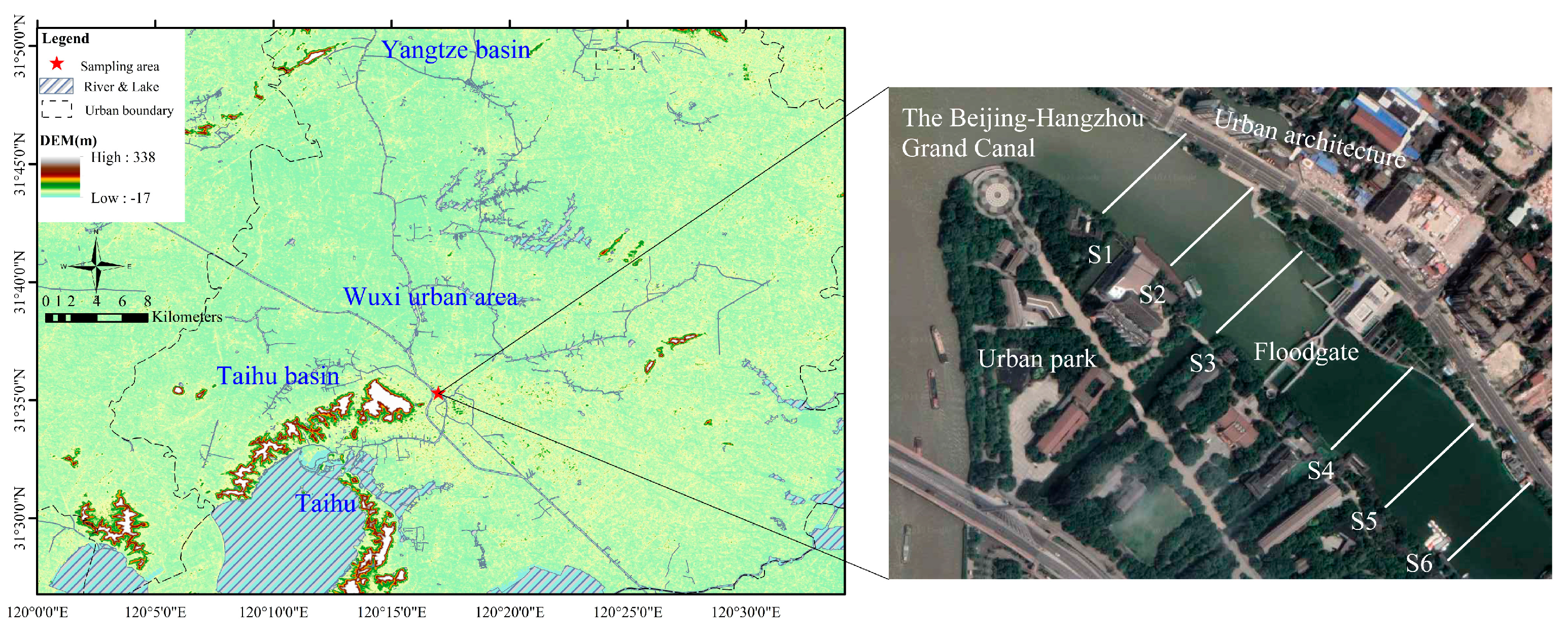
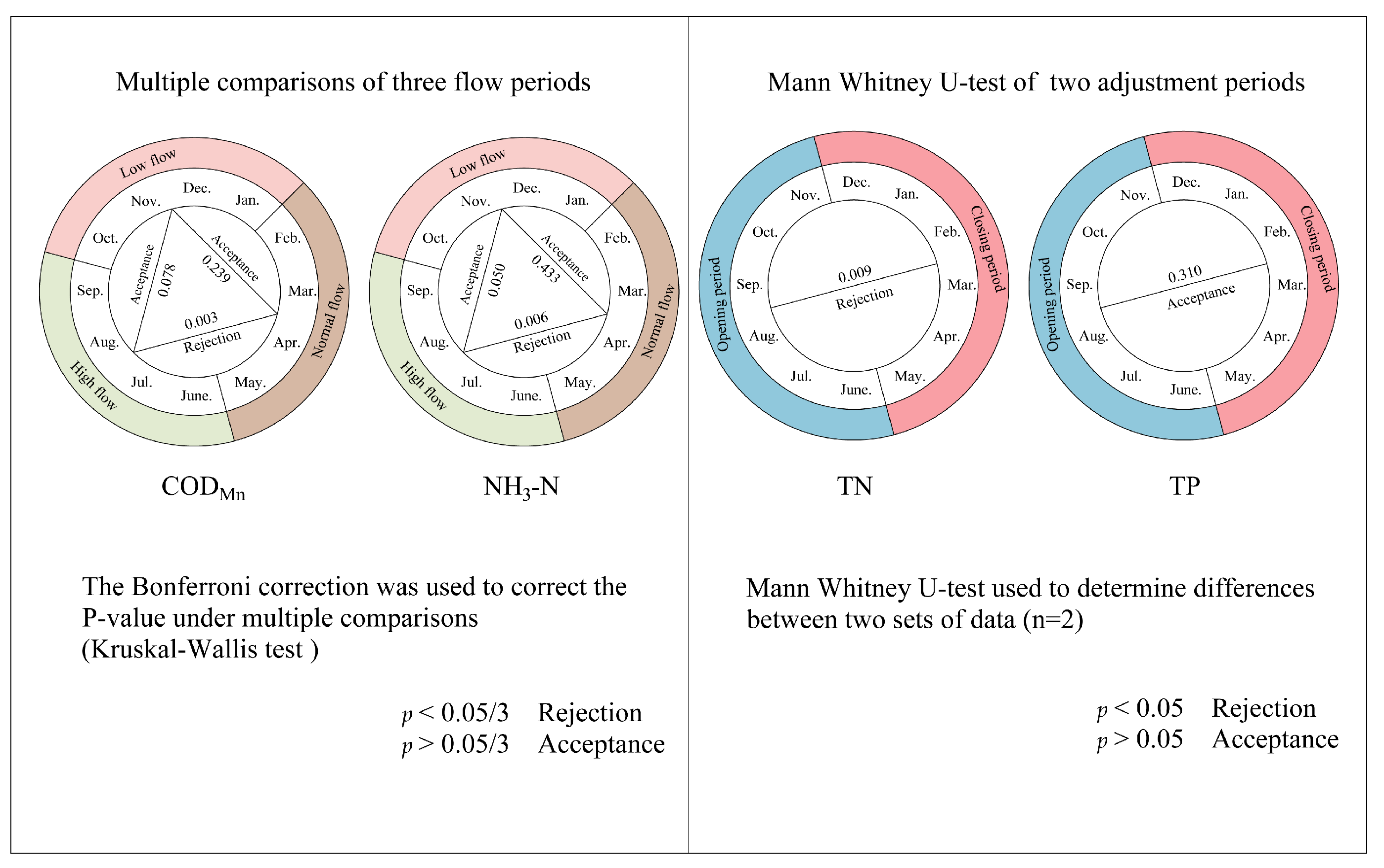
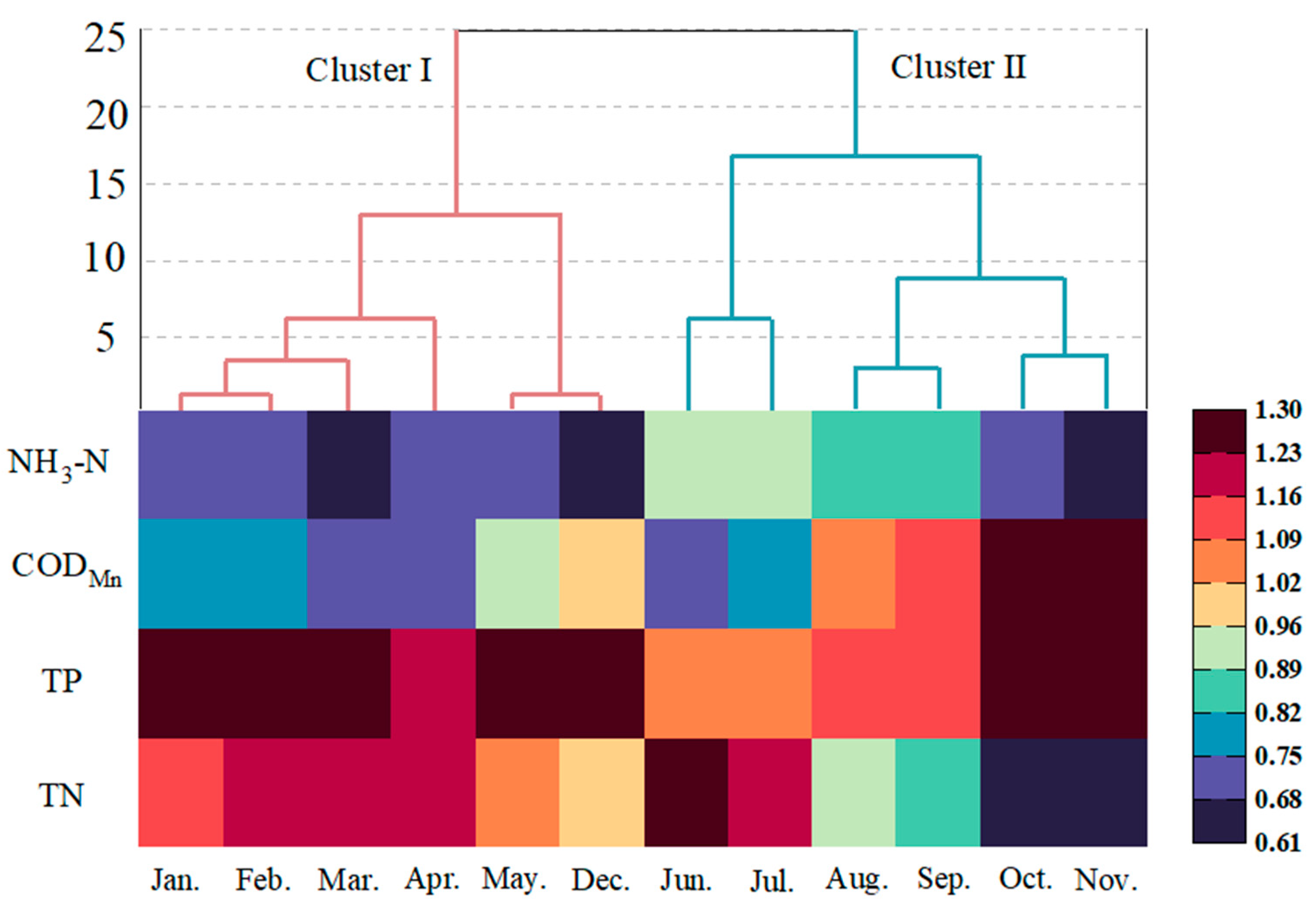
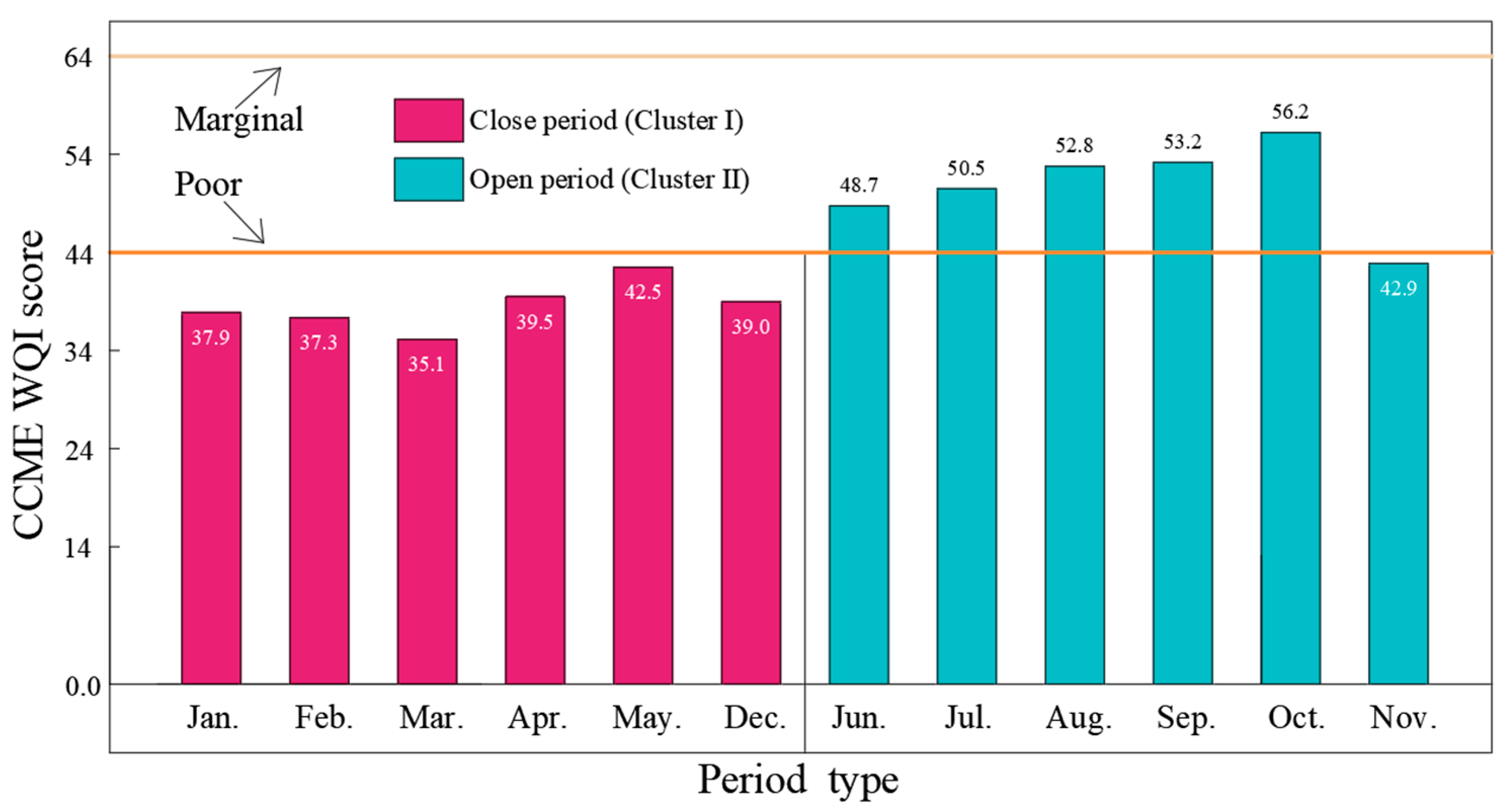
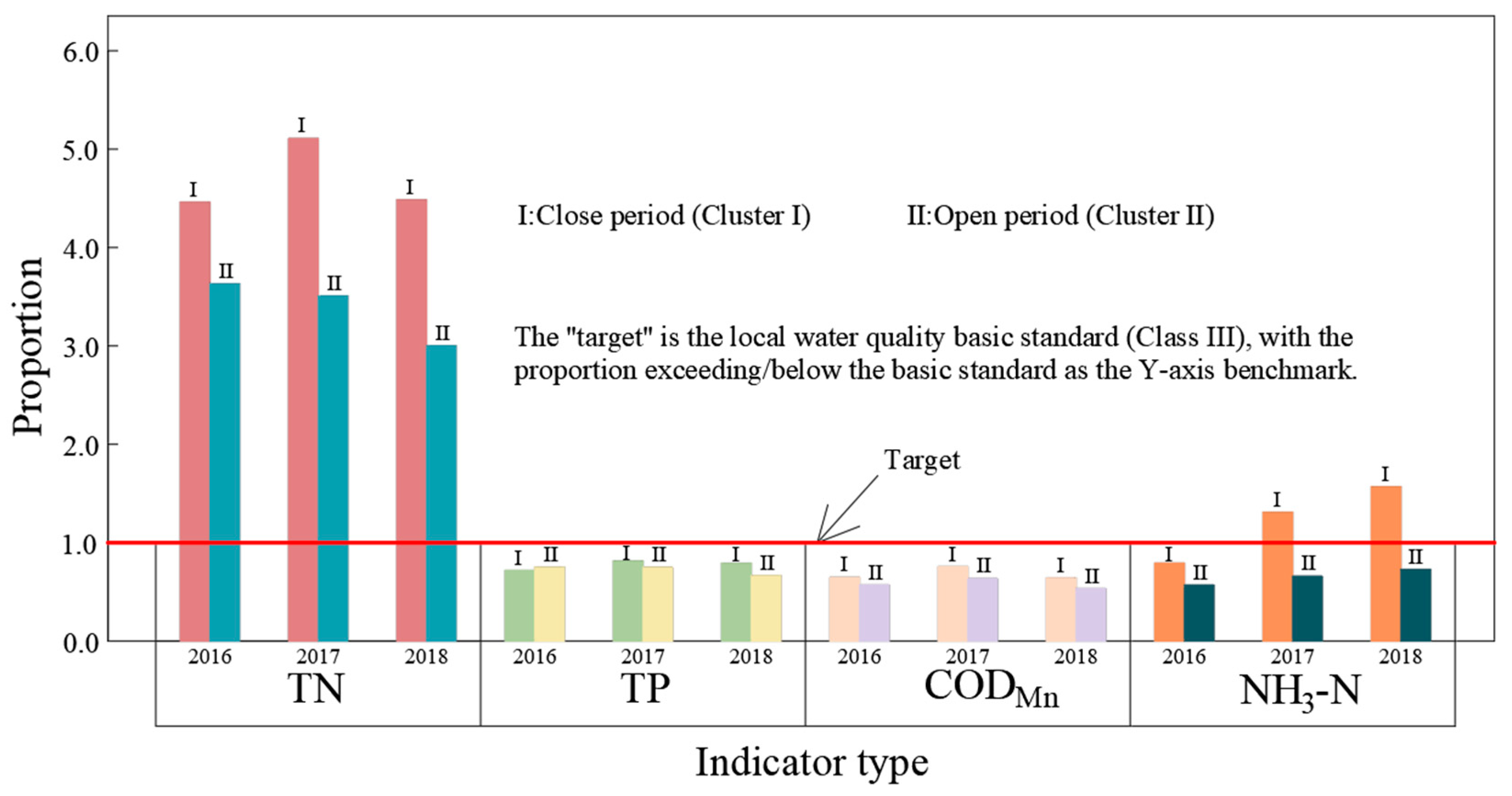

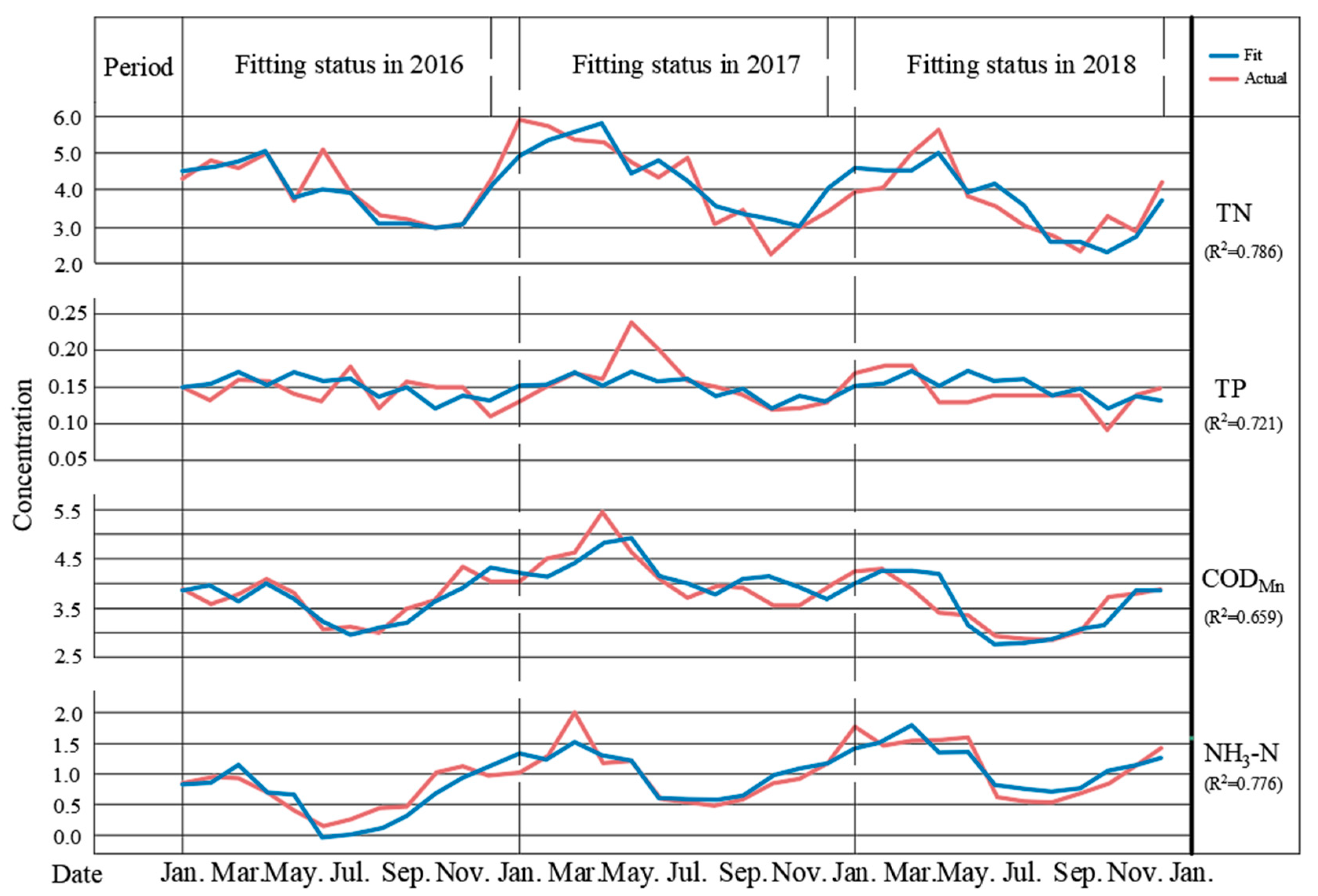
| Index | Hypothesis | Significance | Decision (0.050) |
|---|---|---|---|
| TN | The distribution of water quality data are the same at different water quality periods | 0.058 | Acceptance |
| TP | 0.059 | Acceptance | |
| CODMn | 0.012 | Rejection | |
| NH3-N | 0.018 | Rejection |
Disclaimer/Publisher’s Note: The statements, opinions and data contained in all publications are solely those of the individual author(s) and contributor(s) and not of MDPI and/or the editor(s). MDPI and/or the editor(s) disclaim responsibility for any injury to people or property resulting from any ideas, methods, instructions or products referred to in the content. |
© 2023 by the authors. Licensee MDPI, Basel, Switzerland. This article is an open access article distributed under the terms and conditions of the Creative Commons Attribution (CC BY) license (https://creativecommons.org/licenses/by/4.0/).
Share and Cite
Hu, P.; Feng, L. The Risk of Water Quality Deterioration with Urban Flood Control—A Case in Wuxi. Sustainability 2024, 16, 185. https://doi.org/10.3390/su16010185
Hu P, Feng L. The Risk of Water Quality Deterioration with Urban Flood Control—A Case in Wuxi. Sustainability. 2024; 16(1):185. https://doi.org/10.3390/su16010185
Chicago/Turabian StyleHu, Pan, and Lan Feng. 2024. "The Risk of Water Quality Deterioration with Urban Flood Control—A Case in Wuxi" Sustainability 16, no. 1: 185. https://doi.org/10.3390/su16010185
APA StyleHu, P., & Feng, L. (2024). The Risk of Water Quality Deterioration with Urban Flood Control—A Case in Wuxi. Sustainability, 16(1), 185. https://doi.org/10.3390/su16010185






